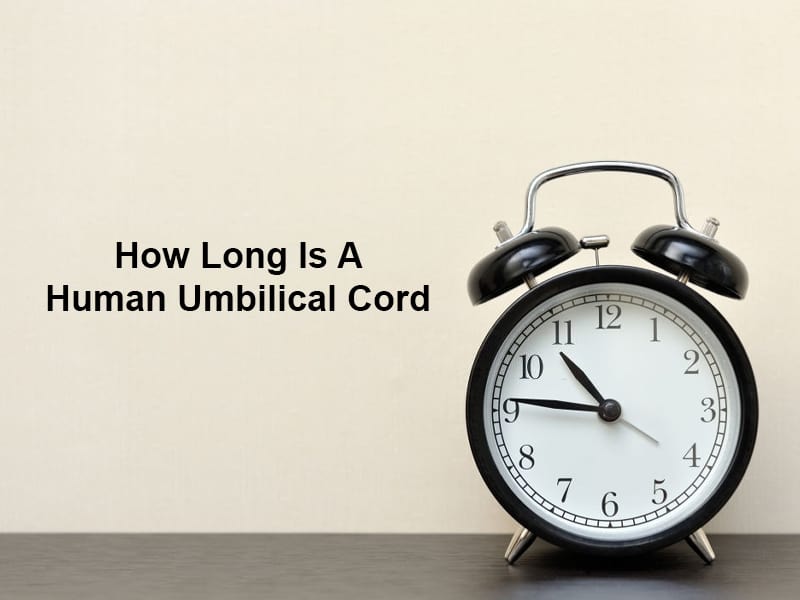Exact Answer: 50-60 cm
The Umbilical Cord is the cord which helps in connecting the baby with the mother during pregnancy. While the fetus is in the uterus, the Umbilical Cord helps in connecting the developing fetus with the placenta.
The Umbilical Cord basically consists of three blood vessels. One of the vein called the Umbilical vein is responsible for the transportation of food and oxygen to the baby from the placenta while the remaining two arteries known as Umbilical arteries are helpful in carrying the waste products from the baby to the placenta.

How Long Is A Human Umbilical Cord?
Umbilical cord starts forming at around the beginning of the 2nd month or the 4th week of pregnancy. Umbilical cord conditions consists of either the cord being very long or in many cases very short which might result in the cord either not getting well connected to the placenta or sometimes getting knotted or squeezed.
| Type Of Umbilical Cord | Length Of Umbilical Cord |
| Short | Less than 30 cm |
| Average | 50-60 cm |
| Long | More than 100 cm |
Umbilical Cords that are less than 30 cm in length are considered short and cause a lot of complications such as psychomotor abnormalities, problems in fetal movement, low birth weight, low Apgar scores, etc. The compression of the Umbilical cord can result in the entanglement of the cord or sometimes the umbilical cord gets wrapped around the fetal neck. During the delivery of the baby, short Umbilical Cord restricts the baby to come out completely and can be very painful for the mother at the time of delivery.
Average Umbilical Cords fall in a range of 50-60 cm. The Umbilical Cords falling in this range don’t hinder the baby’s movement unlike the short ones and also result in good Apgar scores. An Umbilical cord of average size also affects the health of the baby and the mother positively.
Long Umbilical Cords are greater than 100 cm in length. Knots happen very in long Umbilical Cords which can be really harmful for the baby. It also causes Torsion, Cord Prolapse, Delivery Complications, etc.
Why Is A Human Umbilical Cord That Long?
The length of the Umbilical Cord is basically dependent on the tension caused by the freely moving fetus, during the second trimester. Not only this, the Umbilical Cord also represents the index of fetal activity. The Umbilical Cord helps in connecting the abdomen of the fetus to the placenta, which is further connected to the mother’s uterus. Placenta can be attached to the top, side, front or back side of the Uterus. In rarest of many cases, placenta is sometimes attached in the lower area of the uterus which plays a major role in deciding the length of Umbilical Cord.
As during the prenatal development, the Umbilical cord is a part of the fetus. Hence the Umbilical Cord is this long because the cord helps in proper transportation of food and oxygen to the baby. The Umbilical Cord contains a fluid which is heavily loaded with stem cells. The fluid is helpful in the treatment of Cancer, Immune System Disorders and Blood Diseases such as Anaemia.
It is very important that the blood that reaches the fetus is pure and free of any impurities or waste products and the Umbilical Cord is also responsible for the transfer of materials to and from the maternal blood without allowing direct mixing. Thus it is important to have a long Umbilical Cord.
Conclusion
The Length of the Umbilical Cord has a very big range and can vary from one mother to another. However most of the times the length varies from 50-60 cm. Cases of short or long Umbilical Cord have higher incidence of Cord Complications, Intrapartum Complications, increased fetal heart rate abnormalities and many more.
Generally, the length of the Umbilical Cord doesn’t vary according to Weight, Length and Sex of the baby. The Umbilical Cord Stump dries out and eventually falls off after one to three weeks of delivery.
References
- https://link.springer.com/article/10.1007/s13224-012-0194-0
- https://europepmc.org/article/med/7243092

I find it fascinating how the length of the umbilical cord can impact the baby’s health.
Absolutely, the medical implications are profound.
I appreciate the detailed overview of umbilical cord length and its effects.
This is an excellent analysis of an often overlooked aspect of childbirth.
This is fascinating! The complexities of the umbilical cord are astounding.
Certainly an eye-opening read.
I wasn’t aware of many of these details, so thank you for sharing!
An intriguing read, the umbilical cord length can have significant consequences.
Indeed, the impact on fetal health is noteworthy.
It’s crucial that the umbilical cord remains long enough to support the baby’s needs.
Great information, I appreciate the depth of detail included.
Absolutely, this is very insightful.
Fascinating how the umbilical cord is a critical lifeline for the baby.
The biological processes at play here are truly remarkable.
I’m amazed by the intricate functions of the umbilical cord.
This is an eye-opening examination of the umbilical cord and its vital role.
Interesting, but do umbilical cord length have any impact on fetal development?
This had a lot of great information. I’d love to see the research cited here.
Agreed, the references list is quite comprehensive.
It is always good to have research-backed information.
Mind-blowing! I never knew the umbilical cord was so fascinating.
I know, it’s simply amazing.
Very informative piece.